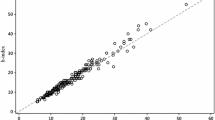Abstract
Based on the foundation laid by the h-index we introduce and study the R- and AR-indices. These new indices eliminate some of the disadvantages of the h-index, especially when they are used in combination with the h-index. The R-index measures the h-core’s citation intensity, while AR goes one step further and takes the age of publications into account. This allows for an index that can actually increase and decrease over time. We propose the pair (h, AR) as a meaningful indicator for research evaluation. We further prove a relation characterizing the h-index in the power law model.
Similar content being viewed by others
References
Hirsch J E. An index to quantify an individual’s scientific research output. Proc Natl Acad Sci USA, 2005, 102(46): 16569–16572
Braun T, Glänzel W, Schubert A. A Hirsch-type index for journals. The Scientist, 2005, 19(22): 8
Egghe L, Rousseau R. An informetric model for the Hirsch index. 2006, Scientometrics, 69(1): 121–129
Rousseau R. A case study: Evolution of JASIS’ h-index. Science Focus (in Chinese), 2006, 1(1): 16–17 (English version available at E-LIS, code 5430)
Banks M G. An extension of the Hirsch index: Indexing scientific topics and compounds. Scientometrics, 2006, 69(1): 161–168
The STIMULATE — 6 Group. The Hirsch index applied to topics of interest to developing countries. First Monday, 2007, 12(2) (http://www.firstmonday.org/issues/issue12 2/stimulate/)
Liu Y, Rousseau R. Hirsch-type indices and library management: The case of Tongji University Library. Proceedings of the 11th ISSI Conference, 2007, Madrid (to appear)
Edwards A W F. System to rank scientists was pedalled by Jeffreys. Nature, 2005, 437(7061): 951
Glänzel W. On the opportunities and limitations of the H-index. Science Focus (in Chinese), 2006, 1(1): 10–11
Rousseau R. The influence of missing publications on the Hirsch index. Journal of Informetrics, 2007, 1(1): 2–7
van Raan A F J. Comparison of the Hirsch-index with standard bibliometric indicators and with peer judgment for 147 chemistry research groups. Scientometrics, 2006, 67(3): 491–502
Ball P. Index aims for fair ranking of scientists. Nature, 2005, 436(7053): 900
Bar-Ilan J. H-index for price medalists revisited. ISSI Newsletter, 2006, 2(1): 3–5
Bornmann L, Daniel, H D. Does the h-index for ranking of scientists really work? Scientometrics, 2005, 65(3): 391–392
Cronin B, Meho L I. Using the h-index to rank influential information scientists. J Am Soc Infor Sci Technol, 2006, 57(9): 1275–1278
Egghe L. Theory and practice of the g-index. Scientometrics, 2006, 69(1): 131–152
Glänzel W, Persson O. H-index for Price medalists. ISSI Newsletter, 2005, 1(4): 5–18
Liang L. h-index sequence and h-index matrix: Constructions and applications. Scientometrics, 2006, 69(1): 153–159
Batista P D, Campiteli M G, Kinouchi O, et al. Is it possible to compare researchers with different scientific interests? Scientometrics, 2006, 68(1): 179–189
Rousseau R. Simple models and the corresponding h-and g-index. Science Technology Development. 2006 (to appear)(see also E-LIS: code ID 6153)
Burrell Q L. Hirsch’s h-index: A stochastic model. J Informetrics, 2007, 1(1): 16–25
Glänzel W. On the h-index—A mathematical approach to a new measure of publication activity and citation impact. Scientometrics, 2006, 67(2): 315–321
Egghe L. How to improve the h-index. The Scientist, 2006, 20(3): 14
Egghe L. An improvement of the H-index: The G-index. ISSI Newsletter, 2006, 2(1): 8–9
Kosmulski M. A new Hirsch-type index saves time and works equally well as the original h-index. ISSI Newsletter, 2006, 2(3): 4–6
Jin B H. H-index: An evaluation indicator proposed by scientist. Science Focus (in Chinese), 2006, 1(1): 8–9
Egghe L. Power Laws in the Information Production Process: Lotkaian Informetrics. Oxford (UK): Elsevier, 2005
Jin B H, et al. Analysis of the development of important subfields in chemistry. China in World Science Series Report 3 (in Chinese). Basic Research Department of the Ministry of Science & Technology and National Science Library of CAS, 2005
Jin B H, et al. Analysis of the development of important subfields in cell biology and genomics. China in World Science Series Report 5 (in Chinese). Basic Research Department of the Ministry of Science & Technology and National Science Library of CAS, 2006
Jin B H, et al. Analysis of the development of important subfields in physics. China in World Science Series Report 6 (in Chinese). Basic Research Department of the Ministry of Science & Technology and National Science Library of CAS, 2006
Rousseau R. New developments related to the Hirsch index. Science Focus (in Chinese), 2006, 1(4): 23–25 (English version available at E-LIS, code 6376)
Jin B H. The AR-index: Complementing the h-index. ISSI Newsletter, 2007, 3(1) (to appear)
Rousseau R. Timelines in citation research. J Am Soc Infor Sci Technol, 2006, 57(10): 1404–1405
Author information
Authors and Affiliations
Corresponding author
Additional information
Supported by a Major State Basic Research Special Program China under grant (No. 2004CCC00400) and National Natural Science Foundation of China (Grant No. 70376019)
About this article
Cite this article
Jin, B., Liang, L., Rousseau, R. et al. The R- and AR-indices: Complementing the h-index. CHINESE SCI BULL 52, 855–863 (2007). https://doi.org/10.1007/s11434-007-0145-9
Received:
Accepted:
Issue Date:
DOI: https://doi.org/10.1007/s11434-007-0145-9




